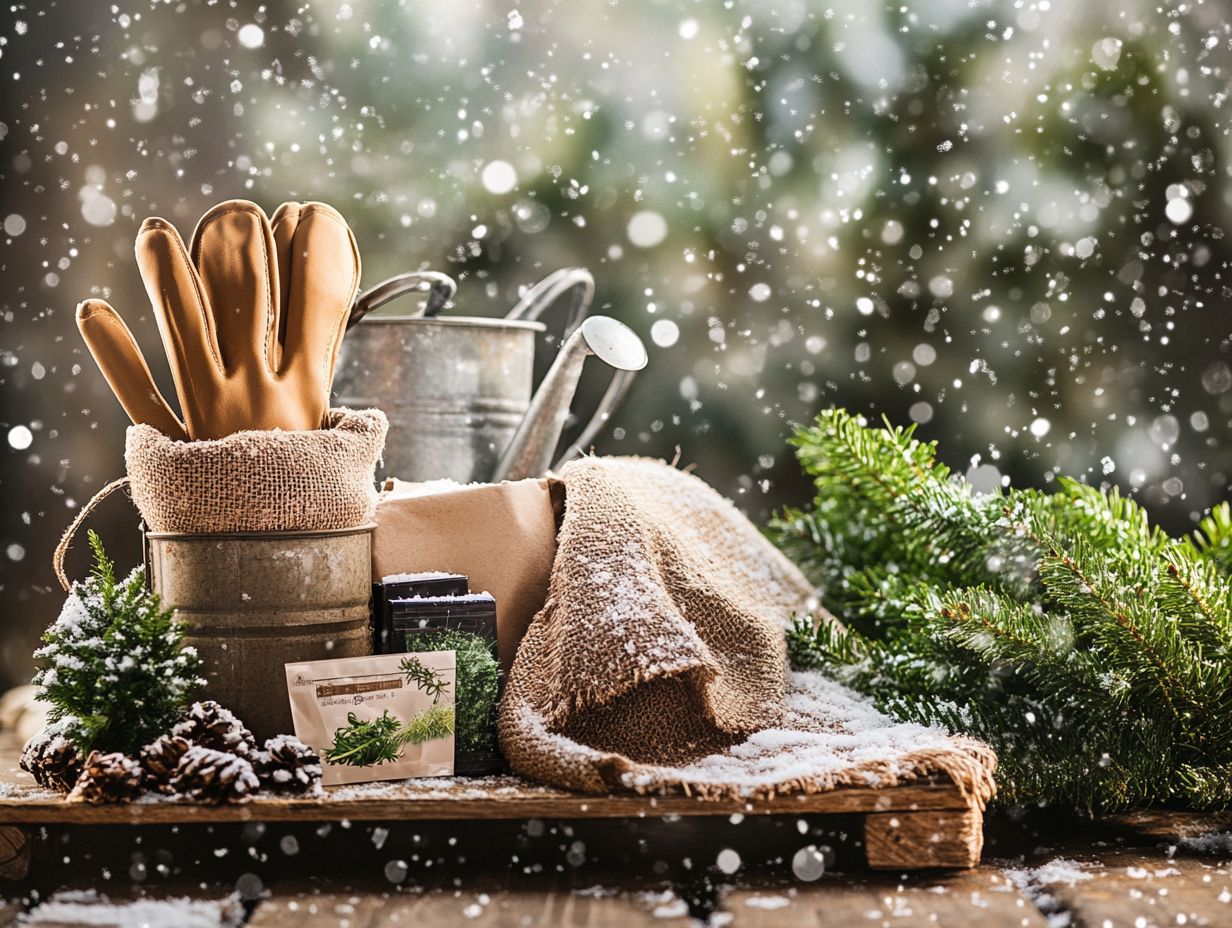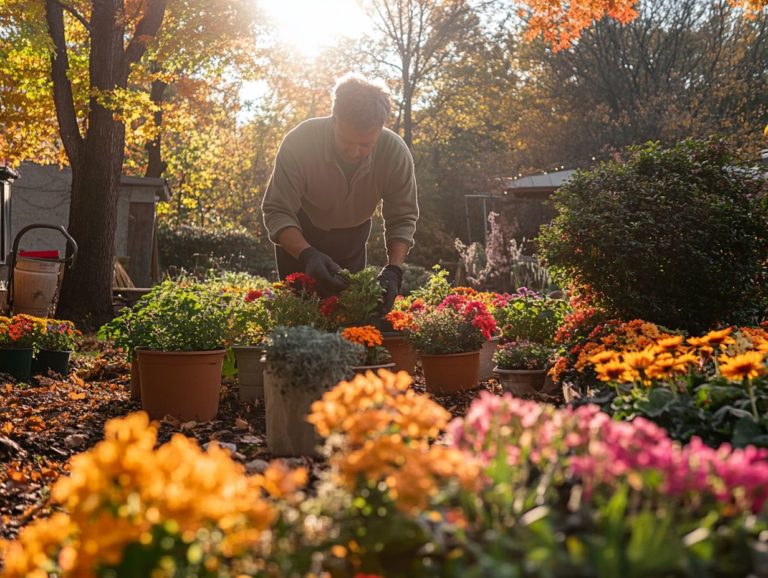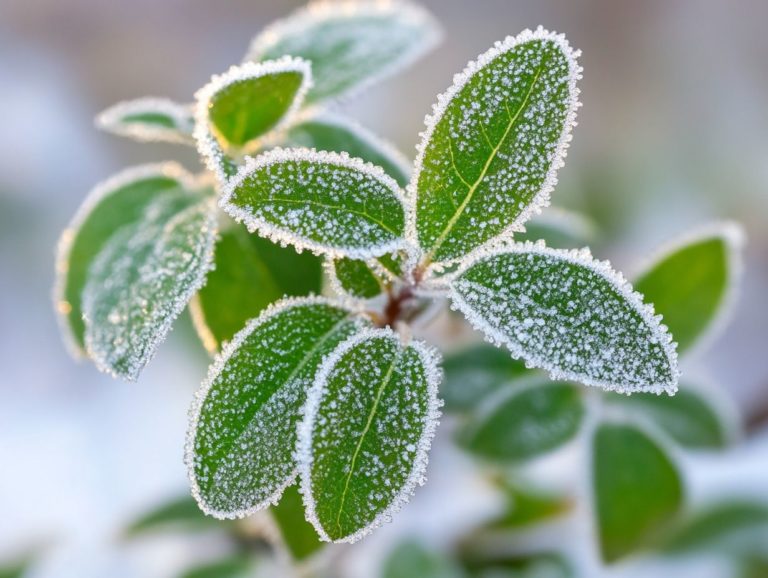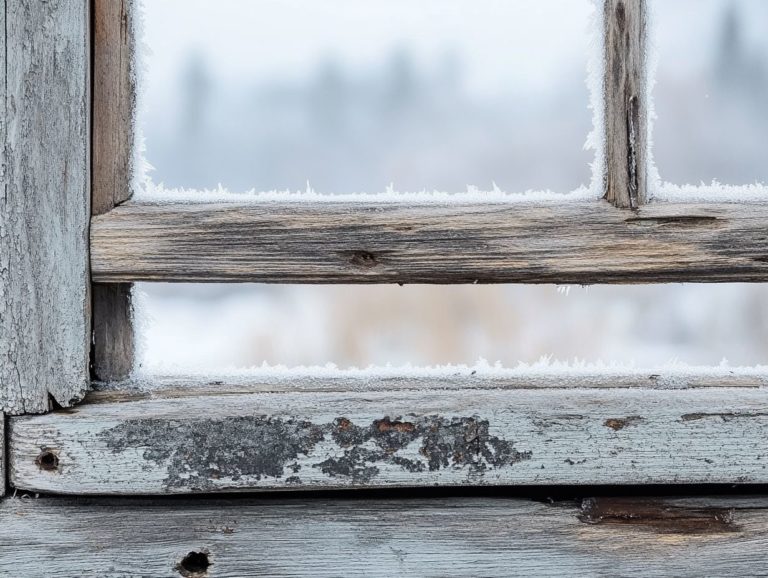Essential Winter Gardening Supplies You Need
As winter envelops the landscape, many gardeners may feel inclined to stow their tools for the season. However, this chilly period presents unique opportunities for nurturing your green thumb.
To ensure you capitalize on your gardening endeavors during these frostier months, consider this curated list of essential gardening supplies. From insulated clothing and robust gloves to specialized tools and winter-appropriate plants, this guide will prepare you with everything necessary to maintain a thriving garden in the cold.
Uncover the must-have items that will transform your winter gardening experience into an enjoyable and rewarding journey!
Contents
- Key Takeaways:
- 1. Winter Gardening Gloves
- 2. Hand Pruners
- 3. Garden Kneeler
- 4. Protective Clothing
- 5. Plant Covers
- 6. Mulch
- 7. Shovel and Spade
- 8. Wheelbarrow
- 9. Frost Cloth
- 10. Winter-Friendly Plants and Seeds
- 11. Watering Can
- 12. Fertilizer
- 13. Pruning Saw
- 14. Garden Rake
- 15. Winter Garden Maintenance Tools
- Frequently Asked Questions
- What are essential winter gardening supplies?
- Do I need to purchase specialized winter gardening supplies?
- How do I choose the right gloves for winter gardening?
- What type of shovel is best for winter gardening?
- Can I use regular tools for winter gardening?
- How can I protect my plants from winter weather?
Key Takeaways:
- Protect your hands with winter gardening gloves to avoid frostbite.
- Use hand pruners for precise trimming during the dormant season.
- Invest in a garden kneeler for comfort while gardening.

1. Winter Gardening Gloves
Winter gardening calls for specialized equipment, and a pair of high-quality winter gardening gloves is essential. These gloves are crafted to protect your hands while providing the dexterity needed for various gardening tasks during the colder months, along with other important tools such as winter pruning tools.
These gloves are often made from a blend of waterproof fabrics and thermal insulation, ensuring your hands remain warm and dry even in brisk conditions. A textured grip enhances your control when handling tools, making tasks like pruning trees or weeding significantly easier.
With the right gloves, you’ll love how easy it is to care for your container plants, safeguarding them against frost while effortlessly maneuvering through soil and garden debris. Whether you’re battling stubborn weeds or making precise cuts, these winter gloves are pivotal in fostering healthy growth and vibrant gardens, allowing you to fully appreciate the beauty of winter blooms.
2. Hand Pruners
Hand pruners are vital tools in your gardening arsenal, enabling you to make precise cuts and maintain your plants effectively, particularly during the winter months when pruning trees and shrubs is key to fostering healthy growth come spring.
These tools come in various styles, each designed to meet unique gardening needs. You can opt for bypass pruners, which offer clean cuts with their curved blades, or anvil pruners, which are ideal for tougher branches.
The ergonomic designs of these pruners ensure comfort and minimize strain during extended use, allowing you to navigate your garden with ease and transforming the task into a more pleasurable experience.
Choosing the right hand pruner elevates the aesthetics of your garden while nurturing the health of your plants, enabling them to flourish as warmer seasons approach and ensuring your gardening experience is both rewarding and productive.
3. Garden Kneeler
A garden kneeler is an invaluable addition to your gardening tools, providing both comfort and support for your various tasks, especially during those chilly winter months. Maintaining soil health and plant maintenance is vital for your plants at this time.
Not only does it cushion your knees and offer a stable base, but this versatile tool also significantly reduces strain on your back and joints while you plant, weed, or care for your containerized plants. It encourages you to linger longer in your cherished garden without discomfort, enhancing both your productivity and enjoyment.
A kneeler helps keep your tools neatly organized, ensuring easy access and streamlining your gardening process. With its sturdy design, it allows you to maintain a comfortable working height, making your entire gardening experience more accessible and less physically taxing.
4. Protective Clothing
Protective clothing is essential for you as a gardener, especially for winter gardening. It not only provides the warmth you need but also shields you from harsh weather conditions, allowing you to maintain focus on cultivating healthy plants. To enhance your gardening experience, consider referring to the ultimate guide to cold weather gardening tools.
To truly embrace the delights of winter gardening, you must equip yourself with the right attire. An insulated jacket is imperative; it will protect you from biting winds while ensuring you can move comfortably. Additionally, consider referring to the essential guide to gardening in cold weather for more tips on how to thrive during the colder months.
A good pair of gloves retains heat and protects your hands from frostbite and moisture. This enables you to work longer without discomfort.
Sturdy boots with excellent insulation and traction are also crucial. They keep your feet warm and prevent slipping on potentially icy surfaces. Together, these elements enhance both safety and overall comfort, enabling you to enjoy a more productive and fulfilling gardening experience, even in chilly temperatures.
5. Plant Covers

Plant covers are essential for safeguarding your garden during the winter months, providing a protective barrier for delicate plants against snow and frost while fostering healthy growth despite the chill.
Among the myriad options at your disposal, horticultural fleece and burlap stand out for their exceptional protective qualities. Horticultural fleece is both lightweight and effective, allowing sunlight and moisture to permeate while insulating your plants from biting winter winds and abrupt temperature fluctuations.
This fabric creates a warm environment around your plants, helping them thrive despite the cold. Maintaining optimal moisture levels is crucial for germination and growth.
Burlap acts as a natural shield against freezing temperatures, effectively protecting your tender plants. Both alternatives not only guard your greenery from harsh weather but also cultivate an environment conducive to thriving, even in the cold.
6. Mulch
Don’t miss out on applying mulch this winter! It s a game-changer for soil health. Applying mulch is an essential practice in gardening, especially during the winter months.
It serves as a protective barrier for the soil, helping to regulate moisture levels and maintain optimal temperatures crucial for plant health.
You’ll find a variety of mulch types at your disposal, each with its own unique benefits and applications. Organic options like wood chips, straw, and leaves not only enrich the soil quality as they decompose but also foster beneficial microorganisms that promote a thriving ecosystem.
In contrast, inorganic mulches such as gravel, rubber, or landscape fabric offer long-lasting coverage with minimal maintenance requirements.
By using mulch wisely, you can cut down on weeds, giving your garden a neat appearance that you’ll love. Choosing the right mulch enhances soil structure, making it an essential element for any winter gardening enthusiast.
7. Shovel and Spade
A shovel and spade are essential gardening tools that play a vital role in managing garden debris and tackling winter tasks. They are crucial for turning the soil and preparing beds for seasonal crops, ensuring proper planting techniques are applied.
While the shovel is primarily designed for lifting and moving bulk materials think snow or compost the spade excels at digging, edging, and creating those crisp, clean lines in your garden.
For winter gardening, using a spade to aerate the soil improves drainage and breaks up any compacted layers, ensuring better nutrient absorption when spring arrives.
The shovel is your best friend for removing old plants and debris, clearing the path for fresh growth. By understanding the unique capabilities of each tool, you can perform your gardening tasks with greater efficiency, enhancing soil health and preparing your beds effectively for the next growing season.
8. Wheelbarrow
A wheelbarrow is truly an essential tool for any gardener. It makes transporting garden debris, soil, and supplies a breeze, especially during those winter months when organization is crucial for maintaining a tidy garden and preparing for seasonal crops.
With the chilly weather often turning tasks into a workout, having a reliable way to move materials can save you both time and energy. Picture yourself effortlessly moving mulch, compost, or tools, allowing for a smoother setup and cleanup during the busy winter season.
A well-organized workspace not only boosts your productivity but also reduces stress, fostering an environment where you can effectively plan and execute seasonal tasks. Whether you’re relocating fallen leaves or moving pots indoors, the wheelbarrow stands as your steadfast ally, streamlining your efforts and ensuring that your garden stays in prime condition throughout the colder months.
9. Frost Cloth
Frost cloth is an essential tool in your winter gardening arsenal, providing that vital extra layer of protection for your sensitive plants against freezing temperatures and unforgiving weather. It ensures plant health throughout the harsh winter months.
You’ll find frost cloths available in a range of options lightweight, medium weight, and heavy-duty crafted from breathable materials like spun polyester or polypropylene. Each type offers varying levels of warmth tailored to the winter conditions in your area.
To maximize its effectiveness, simply drape the cloth over your plants, making sure to secure it at ground level. This technique traps heat while still allowing moisture and light to reach your plants. Not only does this safeguard the foliage from frost, but it also promotes overall plant health, reducing stress during harsh winters and setting the stage for your garden to flourish in the spring.
10. Winter-Friendly Plants and Seeds

Choosing the right winter-friendly plants and seeds is crucial for your winter gardening success. Doing so allows you to grow seasonal crops that can endure the colder months, ensuring vibrant and healthy plants when spring arrives.
As you embark on this journey, consider focusing on hardy vegetables like kale, spinach, and Brussels sprouts. These champions not only thrive in chillier temperatures but also provide a nutritious bounty throughout the season. Don t overlook the beauty of vibrant winter flowers, such as pansies and snapdragons, which can infuse a splash of color into the otherwise gray landscape.
Proper planting techniques are essential. Implementing plant covers can act as protective barriers during those unexpected frost events, safeguarding delicate foliage and encouraging stronger crop resilience. With a bit of preparation and thoughtful choices, your winter garden can be both productive and visually stunning.
11. Watering Can
A reliable watering can is an essential tool in your gardening arsenal, ensuring effective plant care and maintaining optimal moisture levels especially during the winter months when plants are at risk of drying out.
These tools come in an array of shapes and sizes, tailored to meet your diverse gardening needs. For instance, a long-spouted watering can allows for precise watering right at the base of delicate plants, minimizing soil erosion and reducing the risk of fungal diseases. You might also find models with adjustable nozzles particularly handy, as they enable varied water flow ideal for both indoor potted plants and garden beds.
To maximize the benefits of these tools during the colder months, it’s essential to establish a consistent watering routine. This ensures your plants receive the moisture they need without oversaturating the soil. Striking this balance is crucial, as lower temperatures can often mask dry soil conditions, potentially causing stress to winter-hardy species.
12. Fertilizer
Using the right fertilizer is essential for promoting healthy plant growth and ensuring your garden thrives during the winter months. Soil amendments are materials added to soil to improve its quality and can provide the necessary nutrients for your winter gardening success.
Organic options truly shine with their numerous benefits. Organic fertilizers enrich the soil, enhancing its structure, boosting microbial activity, and promoting long-term fertility.
These natural solutions supply essential nutrients and help retain moisture during colder months, vital for root health. By integrating organic fertilizers into your gardening routine, you support soil health and create a sustainable environment where plants flourish, even in winter.
This approach creates a thriving garden that s a joy to cultivate!
13. Pruning Saw
A pruning saw is an essential tool for any gardener, enabling you to make clean cuts and maintain your shrubs and trees effectively during winter tasks. This promotes plant health in the upcoming seasons.
You ll find several types of pruning saws available, each tailored for specific tasks in your garden:
- Crosscut saw: Excels at slicing through thicker branches, making it a reliable choice.
- Folding saw: Offers the bonus of portability without compromising performance.
- Pole saw: Allows you to reach high branches safely, eliminating the need for a ladder.
Effective pruning enhances the aesthetic appeal of your plants and removes dead or diseased wood, significantly improving air circulation and light penetration. This is vital for optimal growth when spring arrives, ensuring that your plants thrive throughout the year.
14. Garden Rake
A garden rake is an essential tool in your gardening arsenal, crucial for managing debris and preparing your space for winter. It ensures your garden remains clean and organized, setting the stage for effective planting and maintenance.
You ll find a variety of rakes, each crafted for specific tasks:
- Leaf rake: Your go-to for gathering fallen leaves and light debris an absolute must during autumn.
- Garden rake: Equipped with sturdier tines, it shines in leveling soil and breaking up clumps.
- Thatching rake: Armed with sharp, closely spaced tines; it efficiently removes moss and thatch from your lawn.
By keeping your garden tidy throughout winter, you not only enhance its aesthetic appeal but also foster healthier soil and plant growth, paving the way for a vibrant spring season.
15. Winter Garden Maintenance Tools

Winter garden maintenance tools are essential for keeping your garden healthy and organized during the colder months. Understanding what tools are essential for cold-climate gardening can help tackle various winter tasks that promote plant care and efficient gardening practices.
Understanding how to use tools like pruners, shovels, and frost blankets can significantly enhance your winter gardening efforts. For instance, pruners are crucial for trimming back overgrown branches, allowing your plants to conserve energy and better withstand harsh weather. Shovels are essential for clearing pathways or preparing beds before snowfall, while frost blankets protect vulnerable plants against freezing temperatures. To learn more about essential tools, check out this guide on creating a winter gardening toolkit.
By utilizing these tools effectively, you can minimize plant stress and nurture a healthier garden ecosystem, setting the stage for vibrant growth come spring.
Frequently Asked Questions
What are essential winter gardening supplies?
Essential winter gardening supplies include gloves, boots, shovels, rakes, and pruners. Additionally, consider using key winter gardening supplies you need, such as cold frames and frost blankets, to protect your plants from the harsh winter!
Do I need to purchase specialized winter gardening supplies?
You may not need to buy specialized winter gardening supplies. An old bed sheet or tarp can work as a frost cover, and a large pot makes a great temporary cold frame. Additionally, you can learn how to make your own cold-weather gardening tools to enhance your gardening experience.
How do I choose the right gloves for winter gardening?
Choose insulated and waterproof gloves. This keeps your hands warm and dry during gardening.
Look for gloves with a good grip to handle tools easily in cold, wet conditions.
What type of shovel is best for winter gardening?
A shovel with a wide, flat blade helps lift snow and frozen soil easily.
Opt for a long handle for better leverage and a metal blade for durability in cold temperatures.
Can I use regular tools for winter gardening?
You can use regular gardening tools for winter tasks. Just clean and dry them thoroughly after use to prevent rust.
How can I protect my plants from winter weather?
Protect your plants from winter weather with frost blankets and plant covers. Natural methods like mulching with leaves or straw can also help insulate plants.
Group potted plants together and cover them with a tarp for added protection.






